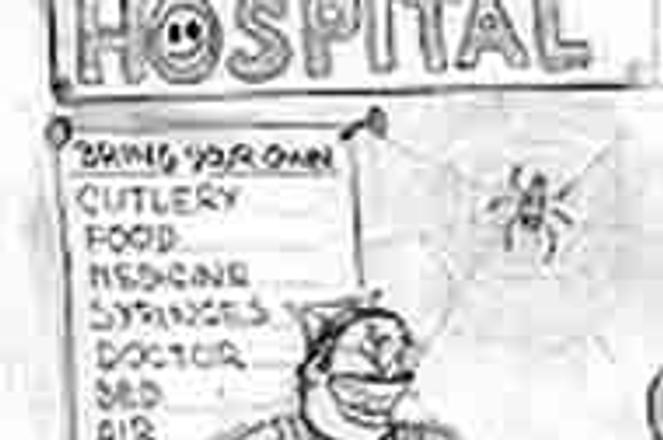illustration: Jan Svrček
Whenever the talk turns to the errors of Slovak government ministers these days, people generally recognise two kinds of sins; those of omission and those of commission.
Health Minister Tibor Šagat has certainly committed no wrong in administering the country's health care system. He's a pleasant, obliging sort of fellow who pedalled valiantly with Prime Minister Mikuláš Dzurinda on the SDK party's bicycle tour of the country last summer. One gets the feeling that he's hard on corruption.
But for sitting on his hands since appointed and letting the country's hospitals deteriorate to the extent they have, Šagat deserves to be fired.
If you have never had occasion to visit an average hospital in Slovakia, and thus lack a clear picture of just what goes on in there, begin by imagining a crumbling communist-era building with apparently no money to spare for anything. That's the reality of Kramáre, the capital's largest hospital.
Patients must bring their own cutlery if they wish to eat, for the hospital does not provide. Meals are served on battered aluminum plates that remind one of childhood camping trips. The food is atrocious - everything is cold, and prepared with neither care nor skill. In the maternity ward, where new mothers recovering from the rigours of childbirth are expected to produce nourishing milk for their children, meals consist of the following: Breakfast - two stale bread rolls and a small hunk of Lunex cream cheese; Lunch - undercooked plain rice and a medallion of meat that is clearly going rotten; Supper - a cauldron of watery soup with two carrots floating in it, a roll with Lunex, a stale sticky bun. God knows what they serve on other floors, where people are either too old or too sick to complain.
Kramáre gives out disposable diapers for newborns only during their first two days of life. From then on, and without warning, babies are allotted five aging cloth 'diapers' with holes in them per night. The problem is that tiny babies often pee more than five times a night, and if the mother is caught off guard and isn't able to ask a family member to buy diapers at a drugstore somewhere, then both mother and baby must suffer the consequences of a night spent in cold, wet clothing. In other words, nobody sleeps.
Little babies often develop a blood condition that looks like jaundice, and is known as "žltačka" in Slovak, at around five days old. It disappears quickly if the baby is exposed to sunshine or a sunlamp, less quickly if the weather is overcast and the entire hospital has one sunlamp for all its newborns. Many new Kramáre mothers spend up to 10 days in the hospital before they are discharged, waiting for their babies' lemon colour to recede - 10 days of inedible food and insufficient supplies.
The remedy for all of this is to buy your own food and pampers, which of course is what most people do. Most people also pay their doctors money under the table for operations, births, plastic surgery procedures - anything from 5,000 to 100,000 Slovak crowns ($120 to $2,400) - to ensure that they receive adequate care and don't wait ages for elective surgery. It's a curious procedure, this bribery - money is never demanded by the doctor, and indeed the topic is never discussed, but people referred to a doctor by friends are often told quietly how much their operation will cost, and the money is submitted in an envelope and never mentioned again.
Surprisingly, the care one gets in the hospital is excellent. Although poorly paid (by the state), doctors and nurses as are committed to their professions here as anywhere else in the world, and are as cheerful as one would expect in the circumstances. Indeed, on the maternity ward at Kramáre, where the doctors quietly accept envelopes and the nurses peddle medical insurance to the mothers of newborns, eveything is as rosy as could be.
Without any leadership from Minister Šagát, the Slovak health care industry has apparently set up its own private schedule of medical costs. These costs, as well as sums for decent food and medical supplies, are paid by those who can afford them, and the energies of the best doctors are reserved for this class of paying patient.
This would be just fine if Slovakia's health care system was arranged on a pay-as-you-play basis. But officially, the state still guarantees free medical care to insured patients. Officially, doctors are not allowed to charge patients for care. Officially, the Health Ministry gets the largest piece of the state budget pie every year.
Where does the money go, if not on providing adequate hospital conditions? Why is the country still pretending it provides free medical care? How long can Minister Šagát go on doing nothing while the health care system falls apart?


